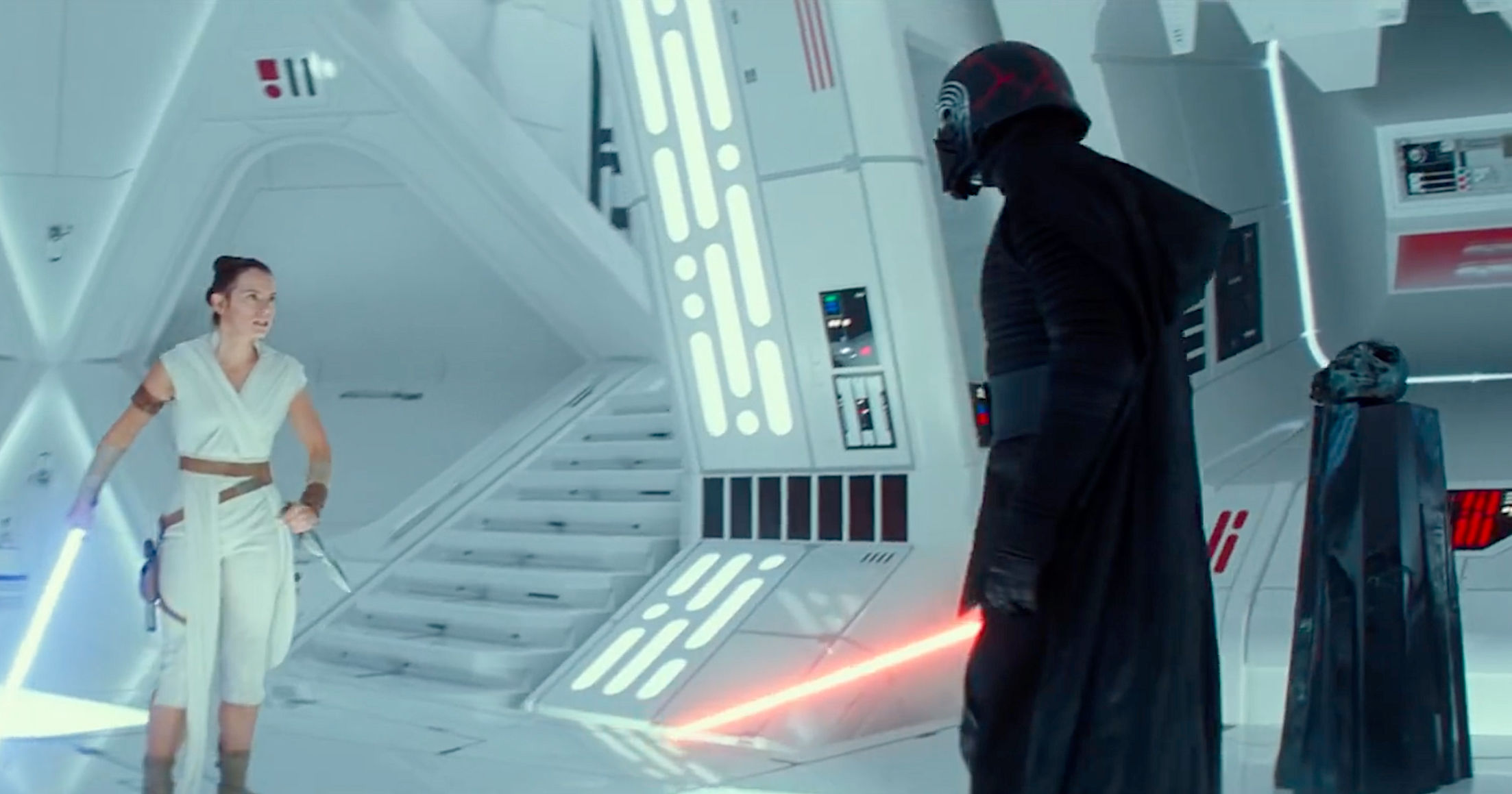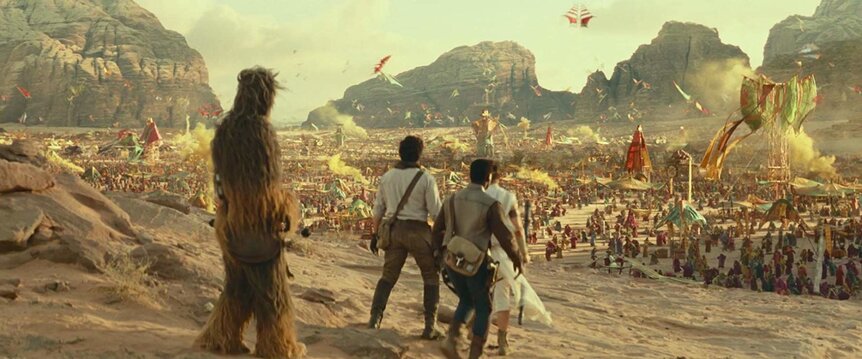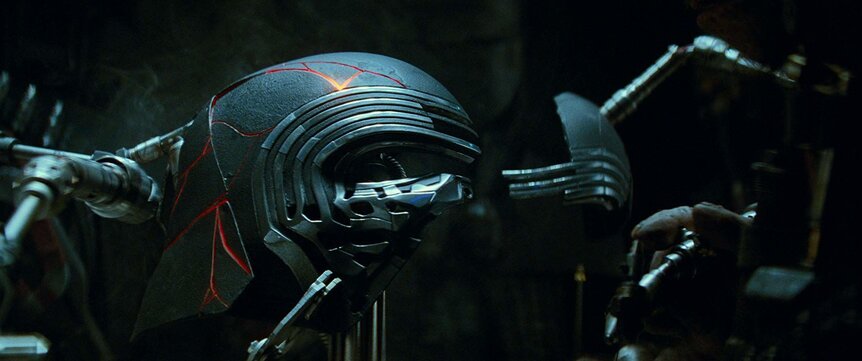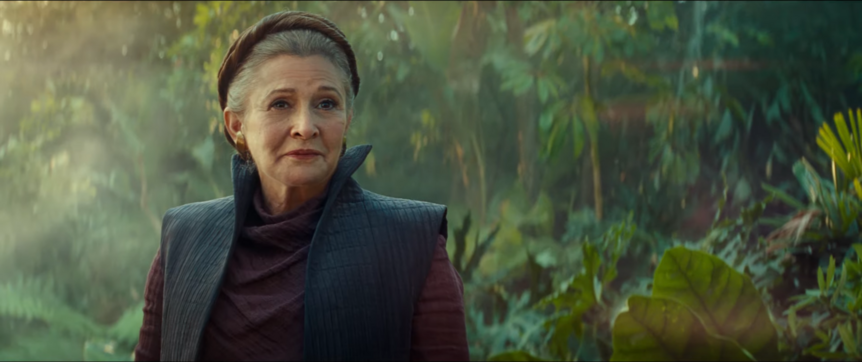Create a free profile to get unlimited access to exclusive videos, sweepstakes, and more!
Secrets of Leia's new digital costume and Kylo's shattered mask in The Rise of Skywalker

When costume designer Michael Kaplan agreed to outfit a new generation of Star Wars heroes (and a bunch of returning favorites, as well), he faced a very unique task. On the one hand, a brand-new trilogy meant he had an opportunity to think up countless new designs and styles; on the other, Star Wars has a very particular aesthetic and fans that pay attention to every little detail, down to the thread.
By the time Kaplan and his team had to get to work on his third Star Wars movie, The Rise of Skywalker, it was all the more challenging. And when you're tasked with everything from the intimate details of Kylo Ren's mask to outfitting hundreds of extras for a desert festival scene, it's more a marathon than a sprint.
"There were 700 people in the hot Jordanian sun that we'd have to dress and put these robes on and jewelry on, put hoods on and these rubber face masks. It was a huge feat … No two are the same," says Kaplan, who will receive the Career Achievement Award at this month's Costume Designers Guild Awards for his work on sci-fi touchstones such as Armageddon and Blade Runner. "We did strange things like lengthening their arms so they looked like creatures as opposed to people in masks."
Kaplan is referring to the alien-wrought actors for the Festival of the Ancestors in The Rise of Skywalker. It's an extremely crucial sequence, as it includes the scene in which heroes Rey, Finn, Poe Dameron, Chewbacca, BB-8, and C-3PO first come across Lando Calrissian. As a result, the massive festival and its celebrants, the Aki-Aki of Pasaana, become something akin to background noise.
So like much of the work Kaplan and his fellow behind-the-scenes artists do, the multi-hued red robes and rubber masks eventually become part of the fabric of the scene more than the focus — more scene-setters and reminders that you're still running around in that fabled galaxy far, far away than outright details to be picked apart.
Star Wars is just as beloved for its over-analyzed-yet-overall-meaningless alien details as it is for the showstoppers. When you're working in the same world as the movies that gave birth to some of the most instantly recognizable characters in film history, your new characters have to be all the more impressive.
Kaplan points out that he's worked on several films with cultural clout. "They've had an effect on fashion," he says. "Like Blade Runner and Fight Club and certainly Flashdance. But taking [Star Wars] on had a different kind of responsibility. It has a history and a fanbase, and I really wanted to make sure justice was done for them.
"J.J. [Abrams] and I discussed not really recreating this world but kind of following in the world that George Lucas had created," he continues. "That's what I tried to do at all times."
When Kylo Ren first appears onscreen in Star Wars: The Force Awakens, he's instantaneously comparable to Darth Vader — the shining black helm, the rasping, mechanical voice, the all-encompassing sense of dread and contempt he inspires in his underlings. That he spends his days meditating over Vader's charred helm and is his literal grandson is extra icing on the cake.
When developing Kylo's helmet for The Force Awakens, Kaplan and his team worked alongside Lucasfilm's concept artists for "months and months and months," cycling through "close to 100" different versions before Kaplan and director Abrams decided they'd gotten it right. Then, after all that work, Adam Driver's Kylo Ren destroys his helmet at the beginning of Star Wars: The Last Jedi, only to have it pieced back together in The Rise of Skywalker because Abrams liked the helmet and wanted to bring it back.
"J.J. had this idea; there's a tradition in Japan when somebody breaks some pottery. They don't just discard it, they put it together again, but they use some gold substance to do that. So they have this veining. And it becomes a whole other thing," Kaplan explains.
He points out that Star Wars has always found some inspiration in Japan's samurai, so Kaplan and Abrams thought it appropriate. And so Kylo's helmet was reborn, rendered all the more haunting by glowing, lava-red lines — lit from inside the helmet, as Kaplan didn't think plain red resin stood out correctly — that reflect how the character himself is also breaking apart.
"They look like arteries," Kaplan says. "You can almost see Kylo's blood boiling."
On the opposite end of the spectrum from Kylo Ren, costume-wise, at least, is Daisy Ridley's Rey, who transitions from sand-stained wraps in The Force Awakens to a pure white, hooded outfit by The Rise of Skywalker.
"J.J. really really loved the costume that we created together on The Force Awakens and really didn't want to let go of it," Kaplan says. "He thought it was iconic, he thought it was Daisy, and [while] we did change it — she now has a hood and the color changed — but we felt it was something that didn't really need to change that much."
He goes on: 'I really wanted [Rey] to complete the trilogy in the same way that Carrie Fisher started it: all in white. I said that to J.J. and to [Lucasfilm President Kathleen Kennedy], and they loved the idea. We did try other colors; we just wanted to change it up a little bit, but the white seemed to stick."
Speaking of Leia, the untimely passing of actress Carrie Fisher before any of The Rise of Skywalker was even written created a significant challenge for the entire production. To round out Leia Organa's story, Abrams and his team used never-before-seen footage Fisher shot for The Force Awakens and then digitally inserted her into The Rise of Skywalker — with a new wardrobe.
"They didn't want to repeat the costume, because that didn't make any sense," Kaplan says. "So I actually made physical costumes for Carrie's character, for Princess Leia, in the same way that I did in the other two films. Thinking of the silhouette that Carrie had worn before and the same color palette — I was actually designing for Carrie Fisher.
"I handed the costume over and somehow it was put on her," he says. "It's remarkable what they can do now [with technology]. Even the jewelry and things that she had worn before, she wasn't wearing it in [the original footage]. They were able to replace the jewelry on her. It was her jewelry that she had worn in another film and suddenly she's there wearing it in [The Rise of Skywalker]."
Anyone who wasn't really paying attention to those details and looking for them, though, wouldn't have noticed. Star Wars fans, despite all their passion and hunger, were likely far more invested in not crying too much whenever Fisher was onscreen in a Star Wars movie for the final time.
Kaplan concludes: "You just kind of accept it and watch the movie and everything seems to be in its place. That's how I'd want it. That's kind of how it is when you do a contemporary movie — or any good costuming. You don't want to upstage anything, you just want it to be part of the action that's taking place."





























